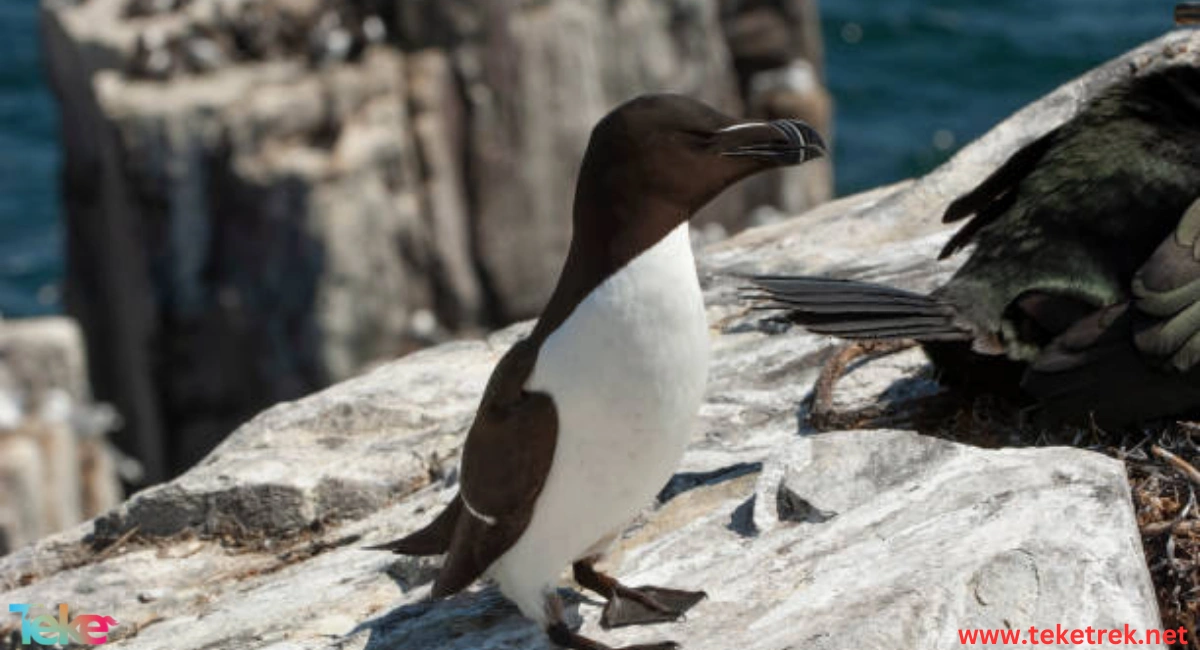It is called Alca torda in scientific terms, belonging to the Alcidae family, the Charadriiformes order, and the Aves class.
Let’s learn more about it from teketrek.

Facts about The Razorbill:
The Razorbill is characterized by choosing only one partner during its lifetime, with the female laying one egg throughout the year.
The Razorbill is a seabird that comes to land only for breeding and mating purposes.
One of its distinctive features is its quiet nature, emitting a low moan that is barely audible.
The Razorbill’s unique beak stands out with its sharp upper edges, serving as a useful tool against predators and prey.
The Razorbill specification:
Measures: The Razorbill measures around 42 cm in length and weighs approximately 750 grams.
Color: It has a black color on the upper part of the neck and head, while the lower part is white.
The Razorbill has a white line under its eyes parallel to the beak, along with black legs.
Beak: Its beak is black and pointed, with white stripes at the tip.
Lifespan:They have a long lifespan of around 13 years. Some species can live for approximately 41 years.
Razorbill habitat: Where do Razorbills live and where can they be found?
Razorbills inhabit North America and can be found in many numbers in northwest France and Russia.
In winter, they migrate to New England or New Jersey, as well as off the coast of New Hampshire.
Razorbills can be found in open seas and marine waters around islands.
What is the diet of Razorbill?
Razorbills are predatory birds that feed on marine animals.
They dive deeply to reach their food and can hold their breath for one minute.
Important foods for puffins include crustaceans, squid, marine worms, and shrimp.
Reproduction stages in Razorbill:
These bird species reproduce when they are four or five years old.
Razorbill mate in mid-May to mid-June, and the eggs hatch after 35 days.
Pairs return to the same coastal cliffs and rocky islands each year to nest.
Razorbills can mate up to 80 times a day over a 30-day period.
Males court and strengthen their bonds with their mates.

FAQs about Razorbills
How many Razorbills are there in the world?
The number of Razorbills is decreasing, especially in Europe, but Scotland and Iceland are home to 60% of these birds worldwide.
Are Razorbill friendly and cute birds?
Razorbill resemble penguins in many aspects and form wonderful flocks of distinctive birds.
How do Razorbill communicate with each other?
Razorbill primarily communicate through some vocalizations and body language that greatly influence their behavior.
The loud braying sound serves as a call or mating request.
Are Razorbill fast birds? What is their speed range?
Razorbills are not considered fast birds, with a maximum speed of 5 km per hour.
Are Razorbill aggressive birds?
Razorbills are not aggressive birds and are less likely to engage in fights with other birds.
Where do Razorbill build their nests?
Razorbills do not prefer to build nests; they pull some gravel and grass with their beaks and lay eggs in them.
They inhabit rocky cliffs and crevices beneath rocks.
Razorbills often lay their eggs in other nests, such as rabbit burrows.
What are the predators of Razorbill?
Seagulls, foxes, ravens, polar bears, and large raptors are among the main predators of these birds.
Humans are also significant predators for feathers, meat, and eggs.
Where do Razorbills migrate?
They migrate between summer colonies and ice-free winter hunting areas.
They must return to their nesting sites to safely raise their chicks, but Razorbill migrate in search of food throughout the year.
. Can Razorbill swim?
Razorbills are skilled swimmers; they often dive for long distances and swim under schools of fish, often swallowing fish to prevent gulls from stealing their food.
Is the razorbill extinct?
Endangered, it is protected under the Migratory Bird Treaty Act.
In conclusion, it is worth mentioning that there are many official efforts being made to protect Razorbill, and we hope that we have provided you with useful information, valuable facts, and amazing insights about Razorbill.
References:





